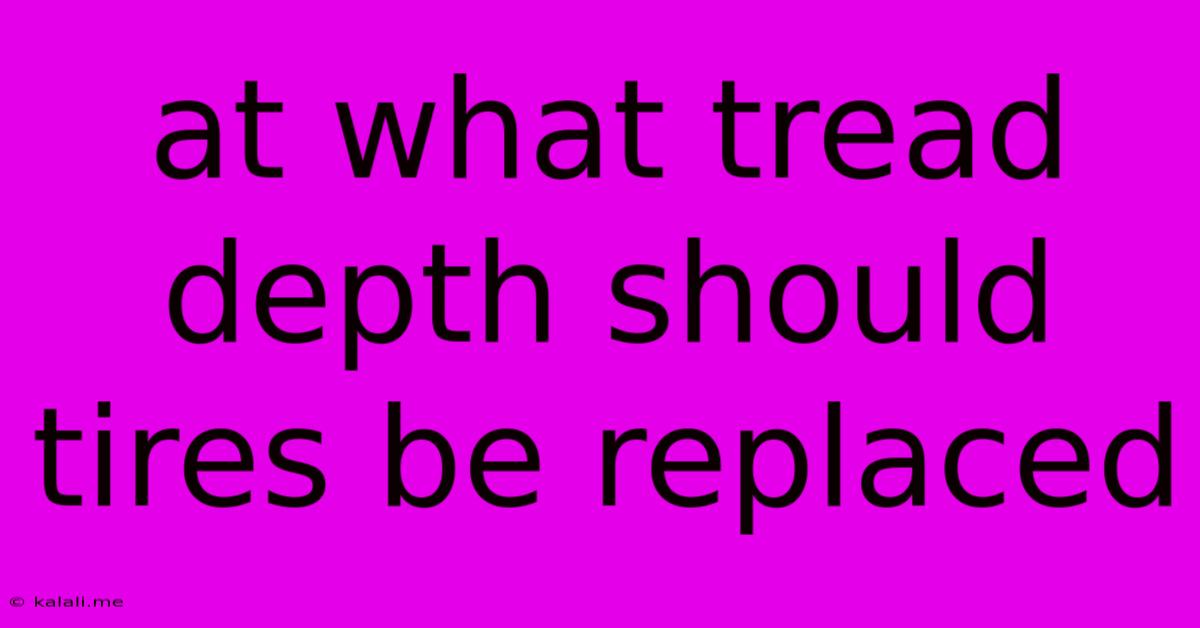At What Tread Depth Should Tires Be Replaced
Kalali
Jun 02, 2025 · 3 min read

Table of Contents
At What Tread Depth Should Tires Be Replaced? A Comprehensive Guide
Meta Description: Learn the crucial tread depth at which you should replace your tires for optimal safety and performance. This guide explains different methods for checking tread depth and provides valuable insights into tire lifespan and maintenance.
Driving on worn-out tires is incredibly dangerous and significantly impacts your vehicle's handling, braking distance, and fuel efficiency. Knowing when to replace your tires is crucial for safety and avoiding costly repairs. But at what tread depth should you actually replace them? This article provides a comprehensive guide to help you determine when it's time for new tires.
Understanding Tire Tread Depth
Tire tread depth is measured in millimeters (mm) or thirty-seconds of an inch (32nds). The depth of the tread directly affects your tire's grip on the road, especially in wet or icy conditions. As the tread wears down, the contact patch between the tire and the road surface reduces, diminishing traction and increasing the risk of accidents.
The Legal Minimum Tread Depth
Most countries have legal minimum tread depth requirements. While these vary slightly, a common standard is 2/32 of an inch (1.6mm). However, driving with tires at this minimum is generally considered unsafe, especially in adverse weather conditions. You should aim to replace your tires well before reaching this minimum.
The Recommended Tread Depth for Optimal Safety
While the legal minimum might be 2/32”, automotive experts strongly recommend replacing tires when the tread depth reaches 4/32 of an inch (3.2mm). At this depth, you'll still have decent grip in most conditions, but driving in heavy rain or snow becomes increasingly risky. Driving at depths below 4/32" significantly increases your stopping distance, particularly on wet roads.
How to Check Your Tire Tread Depth
There are several ways to check your tire tread depth:
-
The Penny Test: Insert a penny into the tread groove with Lincoln's head upside down. If you can see all of Lincoln's head, your tread depth is less than 2/32" and it's time for new tires.
-
The Tread Depth Gauge: This inexpensive tool provides a precise measurement of your tire's tread depth. It’s the most accurate method.
-
Visual Inspection: While not as precise, regularly inspecting your tires for wear and tear, including uneven wear patterns, cracks, bulges, and embedded objects, is crucial.
Factors Affecting Tire Lifespan
Several factors influence how quickly your tires wear down:
-
Driving Habits: Aggressive acceleration, braking, and cornering accelerate tire wear.
-
Road Conditions: Rough roads and frequently driving on gravel or unpaved surfaces contribute to faster tire wear.
-
Tire Pressure: Improper inflation significantly affects tire life and handling. Maintain the recommended tire pressure as indicated on the sticker located inside your driver's side doorjamb.
-
Tire Rotation: Regularly rotating your tires helps ensure even wear across all four tires, extending their lifespan.
-
Alignment and Balancing: Proper wheel alignment and balancing are essential for even tire wear.
Beyond Tread Depth: When to Replace Tires Regardless of Tread Depth
Even if your tires have sufficient tread depth, you may need to replace them if:
-
You notice cracks or bulges in the sidewalls. This indicates potential structural damage and compromised safety.
-
You encounter punctures or damage that can’t be repaired.
-
Your tires are older than six years, regardless of tread depth. Tires age and degrade over time, even if they haven't been driven much. The rubber can become brittle and prone to failure.
Conclusion
Replacing your tires at the appropriate tread depth is vital for your safety and the safety of others. While the legal minimum might be acceptable in some situations, aiming for a tread depth of 4/32" before replacement provides a much safer driving experience, especially in challenging weather conditions. Regular tire inspections and proper maintenance are key to maximizing your tire lifespan and ensuring optimal performance and safety. Remember to consider factors beyond tread depth, such as sidewall damage and age, when deciding when to replace your tires.
Latest Posts
Latest Posts
-
Backward Bending Supply Curve For Labour
Jun 04, 2025
-
How Do I Block An Outgoing Phone Call
Jun 04, 2025
-
Best Place To Buy Ammo Fallout 4
Jun 04, 2025
-
Pdp Afterglow Switch Controller Reset Pc
Jun 04, 2025
-
Google Drive Has Multiple Copies Of Same File
Jun 04, 2025
Related Post
Thank you for visiting our website which covers about At What Tread Depth Should Tires Be Replaced . We hope the information provided has been useful to you. Feel free to contact us if you have any questions or need further assistance. See you next time and don't miss to bookmark.